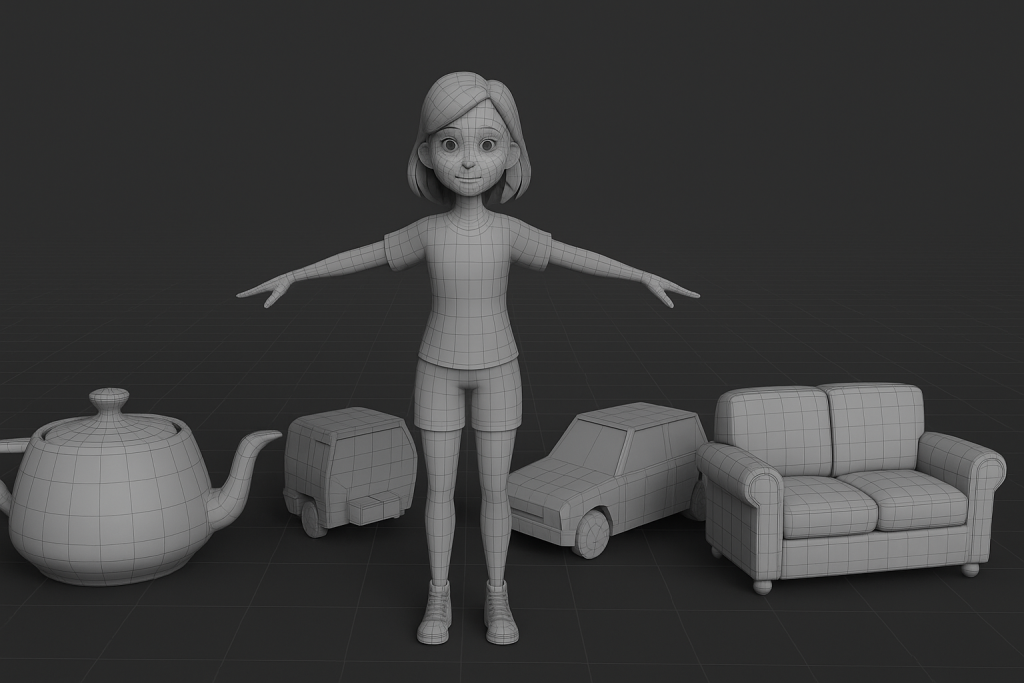If you’ve ever admired a lifelike character in a video game, toured a digital building before it was constructed, or marveled at a 3D-printed prototype, you’ve seen the power of 3D models in action. But what exactly are 3D models, and how are they used across different industries?
In this article, we’ll explore what 3D models are, how they’re made, the most common file types, and the fascinating ways they’re being used in everything from entertainment to engineering.
What Is a 3D Model?
A 3D model is a digital representation of a physical object, space, or even a concept. Unlike flat, 2D images, 3D models include depth, making them appear more lifelike and interactive.
At their core, 3D models are made up of vertices, edges, and faces that form the mesh or structure of the object. Think of it like digital clay. Artists and designers can sculpt, shape, and refine these models to create characters, environments, products, and more.
Some 3D models are simple and low-poly (perfect for mobile games or stylized design), while others are incredibly complex and high-poly, packed with intricate details for use in film or architectural rendering.
How Are 3D Models Created?
Creating a 3D model typically involves one or more of the following methods:
1. Modeling from Scratch
Most 3D artists use software like Blender, Maya, or ZBrush to build models from the ground up. This process involves placing and manipulating vertices and polygons to form the desired shape.
2. 3D Scanning
Physical objects can be scanned using specialized equipment like LiDAR or photogrammetry tools. There are even some affordable, consumer-grade 3D scanners available these days. This technique captures real-world geometry and turns it into a digital 3D mesh. It’s often used in game development, archaeology, and product design.
3. Procedural Generation
In some cases, models are created using algorithms. For example, rather than modeling everything manually, video games and films that require large cities, landscapes and forests will often use procedural generation to create multiple models based on a set of instructions. Software like Houdini is popular for this kind of work.
Common 3D File Formats
Different industries and workflows prefer different file types. Here are a few common ones you’ll come across:
- .OBJ – A universal format, great for sharing models between programs.
- .FBX – Developed by Autodesk, supports animations and widely used in game engines.
- .STL – The go-to format for 3D printing.
- .GLTF/.GLB – Lightweight, web-friendly formats growing in popularity for AR/VR.
If you’re interested in using or converting between formats, check out this handy guide to 3D file types.
How Are 3D Models Used?
Now for the fun part. 3D models aren’t just digital sculptures sitting on hard drives. They’re used in countless industries to power creativity, improve efficiency, and unlock new possibilities.
🎮 1. Video Game Development
In games, almost everything you see – characters, vehicles, weapons, environments – is a 3D model. Developers import models into engines like Unity or Unreal Engine to build immersive worlds.
Low-poly models are common in mobile or stylized games, while AAA titles often use detailed, high-poly versions with advanced texturing.
If you’re looking to use 3D models in your own game project, check out our growing collection of free game-ready assets.
🏗️ 2. Architecture & Real Estate
Architects use 3D models to visualize spaces before they’re built. Clients can explore rooms, landscaping, furniture, and lighting virtually – often using photorealistic rendering or VR walkthroughs.
BIM (Building Information Modeling) is a related field where 3D models aren’t just visual; they also carry data about materials, costs, and logistics.
🎥 3. Film & Animation
From Pixar to Marvel, 3D models are behind almost every modern visual effect. They’re rigged for animation, textured, and lit to fit seamlessly into live-action scenes or fully animated films.
Even smaller indie studios now rely on free or low-cost 3D models to prototype or populate digital scenes.
🏥 4. Healthcare and Medical Visualization
Surgeons and medical researchers use 3D models to visualize complex anatomy or simulate procedures. Dental labs use 3D scans and models to create custom implants or braces, often using digital workflows combined with 3D printing.
🧪 5. Product Design and Manufacturing
Engineers use CAD (Computer-Aided Design) models to test and iterate on prototypes. With 3D printing, those models can be turned into real-world objects in hours.
Even marketing teams use 3D models for product visualization in ads and e-commerce, often replacing traditional photography.
🧙 6. Education and Virtual Experiences
Teachers use interactive 3D models to bring complex subjects to life – like anatomy, astronomy, or historical reconstructions. Museums and tourism companies are also using 3D models to create virtual exhibits and tours.
📱 7. Augmented and Virtual Reality
With the rise of AR and VR, 3D models are at the center of immersive experiences – from AR furniture previews to virtual fashion shows.
Formats like glTF make it easy to integrate models into apps and web experiences without heavy processing.
Where to Find Free 3D Models
Not everyone has time to model from scratch, and that’s where free 3D model libraries come in.
On our site, you’ll find over 600 professionally-crafted 3D models you can download and use for both personal and commercial projects – with no strings attached. We don’t even ask you to register or to give up any personal information in order to access our free models. Whether you’re building a game, mocking up a design, or creating visual effects, we’ve got assets to help.
👉 Browse our free 3D model library here
3D models are more than just digital eye candy – they’re tools that power creativity, communication, and innovation across the globe. Whether you’re a student just starting out or a professional looking to streamline your workflow, understanding how 3D models work and where to find them can give you a serious edge.
And remember, every great creation starts with a great model. So why not start exploring assets for your next project today?
